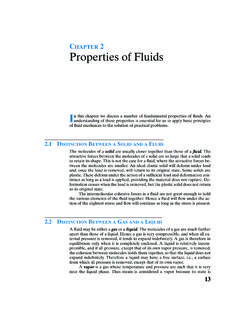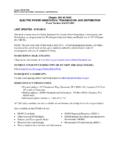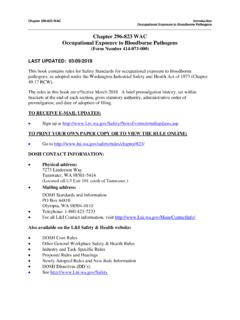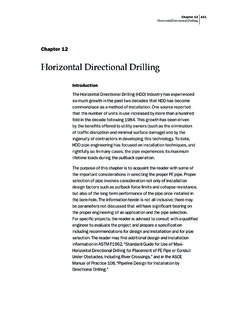Transcription of Section 4 Maintenance fluids electrolytes - …
1 The primary focus of intravenous fl uid replacement therapy is to provide for a child s Maintenance and defi cit fl uid needs. Main-tenance fl uid needs are met by replacing fl uids and electrolytes lost through normal body processes (for example, metabolism and respiration). Defi cit fl uid needs are met by replacing the fl uids and electrolytes lost before therapy began. Additional fl uids may be needed to replace abnormal losses that continue during therapy (for example, persistent vomiting, diarrhea, or nasogastric tube drainage). This Section shows how to calculate a patient s Maintenance fl uid needs.
2 The sample problems allow you to practice your fl uids and electrolytes4 Section30 Pediatric fluids and ElectrolytesDaily Maintenance fl uid needsDaily Maintenance fl uids are those needed to replace:Insensible fl uid losses from the skin and lungs. Urine and stool losses that result from normal are many nomograms and other tables that help you deter-mine Maintenance fl uid needs. Generally, these calculations are based on an estimate of a child s body surface area, body weight, or calories expended. The most common method for calculating Maintenance fl uids is the Holiday-Segar method, which is based on the child s body weight.
3 This method converts the caloric requirements of a child into free water requirements. It relies on the principle that one milliliter of water is spent for each calorie a child uses. Therefore, fl uid needs can be determined directly from the calorie expendi-ture. Infants have higher caloric requirements per kilogram than older children. This method divides caloric (and therefore free wa-ter) needs into three categories based on body weight, as described in the table : Daily Maintenance fl uid needsWeightFluid needs per 24 hoursNewborn (0 72 hours)60 100 ml/kg0 10 kg (0 22 lb)100 ml/kg11 20 kg (24 44 lb)1000 ml plus 50 ml/kg > 10 kg> 20 kg (> 44 lb)1500 ml plus 20 ml/kg > 20 kgExample 1: An infant who weighs kg (12 lb) requires 550 ml (100 ml x kg) of fl uid per day to meet Maintenance 2.
4 A 10 year old who weighs 30 kg (66 lb) requires 1700 ml [1500 ml + (20 ml/kg x 10 kg)] of fl uid per day to meet mainte-nance needs. Maintenance fl uids and electrolytes 31 Application: Calculating daily Maintenance fl uid needs Instructions: Using the table provided, calculate the fl uid mainte-nance requirement per 24-hour period for each child. Then deter-mine the amount of fl uid (in milliliters) each child needs per : Daily Maintenance fl uid needsWeightFluid needs per 24 hoursNewborn (0 72 hours)60 100 ml/kg0 10 kg (0 22 lb)100 ml/kg11 20 kg (24 44 lb)1000 ml plus 50 ml/kg > 10 kg> 20 kg (> 44 lb)1500 ml plus 20 ml/kg > 20 kgMegan, age 11 years Kilogram weight = kg (72 lb) fluid Maintenance needed per 24 hours _____.
5 fluid Maintenance needed per hour _____. Andrew, age 2 years Kilogram weight = kg (26 lb) fluid Maintenance needed per 24 hours _____. fluid Maintenance needed per hour _____. Emily, age 4 weeksKilogram weight = kg (8 lb) fluid Maintenance needed per 24 hours _____. fluid Maintenance needed per hour _____. David, age 7 years Kilogram weight = 22 kg (48 lb) fluid Maintenance needed per 24 hours _____. fluid Maintenance needed per hour _____. Pediatric fluids and ElectrolytesSarah, age 15 months Kilogram weight = 11 kg (24 lb) fluid Maintenance needed per 24 hours _____.
6 fluid Maintenance needed per hour _____. Application answersAll answers below are based on the Scale: Daily Maintenance fl uid needs table on page ml + (20 ml/kg x kg) = 1754 ml per 24 hours. 1754 ml/24 hours = 73 ml per ml + (50 ml/kg x kg) = 1090 ml per 24 hours. 1090 ml/24 hours = 45 ml per ml/kg = 100 x kg = 360 ml per 24 ml/24 hours = 15 ml per ml + (20 ml/kg x 2 kg) = 1540 ml per 24 ml/24 hours = 64 ml per ml + (50 ml/kg x 1 kg) = 1050 ml per 24 ml/24 hours = 44 ml per 4:2:1 ruleThe 4:2:1 rule simplifi es and speeds up calculations.
7 IV fl uid rates are written per hour rather than per day. Although you can divide the daily total by 24 to get the hourly rate, that can be diffi cult to do in your head (as it is for the authors of this book).The 4:2:1 rule closely approximates the long route. Consider that 100 ml/kg/day / 24 hours = ml/kg/hour (close to 4), 50 ml/kg/day / 24 hours = ml/kg/hour (close to 2), and 20 ml/kg/day / 24 hours = ml/kg/hour (close to 1).






